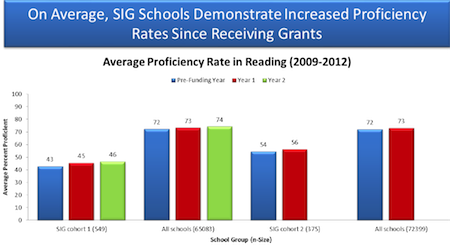Last Thursday, I jokingly tweeted that since the next day would be a snowy Friday before a holiday weekend, the U.S. Department of Education would probably release School Improvement Grants (SIG) data. (They’ve executed numerous SIG-related “Friday afternoon trash dumps” in an attempt to minimize the field’s attention to this failed—and massively expensive—program.)
Turns out my joke wasn’t funny at all.
They’ve done it again.
As you might remember, several months ago, the Department released second-year results, meaning two years of data from cohort-one SIG schools and one year of data from cohort-two schools. But they had to retract the data because of mistakes made by a contractor.
So today, they’ve released the corrected information.
On a Friday afternoon.
Before a holiday weekend.
I’ve belabored the fiasco that is SIG, so I won’t pile on today. I just hope someone, someone, in the Department is saying, “If we find ourselves continually dumping bad SIG news, shouldn’t we just admit we messed up and ask Congress to end this program?”
Here’s what you need to know.
• When the program launched, we were told that this now-$6 billion program would produce “dramatic” improvements in our most troubled schools. The Secretary talked of “transformation not tinkering.”
• The most persistently low-performing schools in America got several million dollars, on average, and yet a third of them got worse.
• On average, schools with two years of funding and interventions under their belts saw a three percentage point gain in reading proficiency—just about the same gain as all other U.S. schools—those that didn’t get these huge cash infusions. (Today’s corrected data is worse than the initial release—gains here went down from five points to three points.)
• On average, schools with one year of funding and interventions under their belts saw a two percentage-point gain in reading proficiency—just about the same gain as all other U.S. schools that didn’t get these huge cash infusions.

If this graph doesn’t convince you that we’ve misspent billions of dollars, I’m not sure what would.
And worse, because of language in the recent omnibus budget, states and districts have the opportunity to implement even weaker interventions with SIG funds.
SIG: The greatest failure in the U.S. Department of Education’s 30-plus year history, and we saw it coming.
—Andy Smarick
This first appeared on the Fordham Institute’s Flypaper blog.


